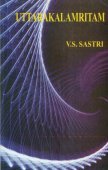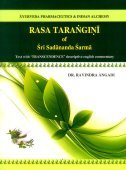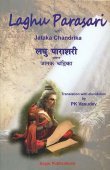Paddhati, Paddhatī: 18 definitions
Introduction:
Paddhati means something in Hinduism, Sanskrit, Marathi, Hindi. If you want to know the exact meaning, history, etymology or English translation of this term then check out the descriptions on this page. Add your comment or reference to a book if you want to contribute to this summary article.
In Hinduism
Shaivism (Shaiva philosophy)
Source: Shodhganga: Iconographical representations of ŚivaPaddhati (पद्धति, “digests”).—Śaivāgama digests are generally called as paddhatis. In other words they are the manual(s) that are compiled by the teachers of this school. They have condensed and culled out the subject matter from the Mūlāgamas, which are in Śloka form and presented them in the form of Prayoga. The paddhati writers mainly deal with the Kriyā and Caryā sections of Mūlāgamas.
There is also another theory that the sacred knowledge emanated from Śiva is said to have taught by Nandin to Sanaka, Sanātana, Sanandana and Sanatkumāra. They have established four mutts called Āmardaka, Raṇabhadra, Kolagiri and Puṣpagiri on the slopes of Himalayas. Out of these four mutts other eighteen mutts are established by different Āgamic seers and later they authored the manuals which are named after their respective founders.
Totally there are eighteen paddhatis and their authors are as follows:
- Durvāsa,
- Piṅgala,
- Ugrajyoti,
- Śrīkaṇṭha,
- Viṣṇukaṇṭha,
- Subodha,
- Vidyākaṇṭha,
- Rāmakaṇṭha,
- Jñānakaṇṭha,
- Jñānaśaṅkara,
- Somaśambhu,
- Brahmaśambhu,
- Trilocanaśiva,
- Aghoraśiva,
- Varuṇaśiva,
- Prasādaśiva,
- Rāmakaṇṭhaśiva
- Īśānaśiva.
Among the above mentioned authors, the work of Aghoraśiva has gained popularity in this school owing to its style. It is considered as a ready reckoner in ritualistic part. The paddhati of Somaśambhu, Īśānaśiva and Varuṇaśiva are published in the latter half of twentieth century A.D.
Source: academia.edu: Religious Inclusivism in the Writings of an Early Modern Sanskrit Intellectual (Shaivism)Paddhati (पद्धति) refers to a “Śaiva ritual manual” .—Appaya composed numerous devotional hymns dedicated to Śiva and polemical works defending the supremacy of Śiva; he is also the author of an influential Śaiva ritual manual (paddhati), the Śivārcanacandrikā. On the other hand, he was also a very committed Advaitin―he authored the monumental Parimala, a subcommentary in the Bhāmatī tradition and several other Advaita works, some of which are still read today in South India―as well as a Mīmāṃsaka trained in the Bhāṭṭa tradition.

Shaiva (शैव, śaiva) or Shaivism (śaivism) represents a tradition of Hinduism worshiping Shiva as the supreme being. Closely related to Shaktism, Shaiva literature includes a range of scriptures, including Tantras, while the root of this tradition may be traced back to the ancient Vedas.
Shaktism (Shakta philosophy)
Source: Google Books: ManthanabhairavatantramPaddhati (पद्धति) refers to “sequence” (of metaphysical principles), according to the Tantrāloka:—Accordingly, “[...] If the nectar of emission (visargāmṛta) is thus emitted into the fire called (individual) consciousness (bodha), the entire cosmic order is offered as oblation. For the emission of the Lord of the Absolute (anuttaranātha) is the Mistress of Kula (kulanāyikā) and its arousal (kṣobha) is the (letters of the Sanskrit alphabet) ranging from Ka to Ha whose expansion (prasara) is the sequence (paddhati) of metaphysical principles (ranging from Earth to Śakti). [...]”.

Shakta (शाक्त, śākta) or Shaktism (śāktism) represents a tradition of Hinduism where the Goddess (Devi) is revered and worshipped. Shakta literature includes a range of scriptures, including various Agamas and Tantras, although its roots may be traced back to the Vedas.
General definition (in Hinduism)
Source: Academia.edu: The Rite of Durgā in Medieval BengalPaddhati (पद्धति):—These scriptures ultimately guide all religious ceremonies within Brahmanism, a religion that, from its mostarchaic manifestation in the Vedas, has privileged sacred text in sanctioning all matters ofdoctrine and practice. According to the learned medieval exegete Bhaṭṭa Rāmakaṇṭha: For any scripture a Paddhati is a text which enables the performance of the rituals of that scripture along with the Mantras that accompany them by succinctly arranging in the order of performance (i) the instructions explicitly stated in that scripture but dispersed in various places throughout its length, and (ii) whatever else those explicit statements imply. An example is the Yajñasūtra in the case of the [Kāṭhaka] Yajurveda.
Languages of India and abroad
Marathi-English dictionary
Source: DDSA: The Molesworth Marathi and English Dictionarypaddhati (पद्धति).—f (S) pop. paddhata f Way, mode, the usual or the proper manner, a course of practice. 2 A work prescribing rites and ceremonies; a ritual, a manual, a formulary. 3 A line, a row or range.
Source: DDSA: The Aryabhusan school dictionary, Marathi-Englishpaddhati (पद्धति).—f paddhata f Way, mode. A Ritual. A line, a row.
Marathi is an Indo-European language having over 70 million native speakers people in (predominantly) Maharashtra India. Marathi, like many other Indo-Aryan languages, evolved from early forms of Prakrit, which itself is a subset of Sanskrit, one of the most ancient languages of the world.
Sanskrit dictionary
Source: DDSA: The practical Sanskrit-English dictionaryPaddhati (पद्धति) or Paddhatī (पद्धती).—f. (
Derivable forms: paddhatiḥ (पद्धतिः).
Paddhati is a Sanskrit compound consisting of the terms pad and hati (हति).
Source: Cologne Digital Sanskrit Dictionaries: Shabda-Sagara Sanskrit-English DictionaryPaddhati (पद्धति).—f. (-tiḥ-tī) 1. A road. 2. A line, a row or range. 3. A ritual, a manual, a work upon any act or ceremony, detailing the mode of its performance, and collecting the texts connected with it. 4. A family name, a surname or title. E. pad a foot, han to strike, aff. ktin .
Source: Cologne Digital Sanskrit Dictionaries: Benfey Sanskrit-English DictionaryPaddhati (पद्धति).—i. e. pad-han + ti, f. 1. A way, a path, [Raghuvaṃśa, (ed. Stenzler.)] 11, 87. 2. A guide, designation of a class of literary compositions.
Source: Cologne Digital Sanskrit Dictionaries: Cappeller Sanskrit-English DictionaryPaddhati (पद्धति).—[feminine] footstep, track, way, path; leader, guide, guide-book.
Source: Cologne Digital Sanskrit Dictionaries: Aufrecht Catalogus Catalogorum1) Paddhati (पद्धति) as mentioned in Aufrecht’s Catalogus Catalogorum:—vaid. Oudh. Xviii, 6.
—Vs. by Vaidyanātha. Peters. 2, 172.
2) Paddhati (पद्धति):—jy. by Keśava. B. 4, 118. See Jātakapaddhati by Keśava.
Source: Cologne Digital Sanskrit Dictionaries: Monier-Williams Sanskrit-English Dictionary1) Paddhati (पद्धति):—[=pad-dhati] f. (for -hati) ‘foot-stroke’, a way, path, course, line, [Harivaṃśa; Kāvya literature] etc. (also tī [gana] bahv-ādi)
2) [v.s. ...] sign, token, [Jātakamālā]
3) [v.s. ...] Name of a class of writings (described as guide-books or manuals for [particular] rites and ceremonies and the texts relating to them) and of sub voce works.
4) [v.s. ...] a family Name or title (or rather the characteristic word denoting caste or occupation in comps. serving as proper names e.g. -gupta, -dāsa at the end of Vaiśya and Śūdra names), [cf. Lexicographers, esp. such as amarasiṃha, halāyudha, hemacandra, etc.]
Source: Cologne Digital Sanskrit Dictionaries: Yates Sanskrit-English DictionaryPaddhati (पद्धति):—(tiḥ) 2. f. A road; a row; a ritual; a surname or title.
Source: DDSA: Paia-sadda-mahannavo; a comprehensive Prakrit Hindi dictionary (S)Paddhati (पद्धति) in the Sanskrit language is related to the Prakrit word: Paddhai.
[Sanskrit to German]
Sanskrit, also spelled संस्कृतम् (saṃskṛtam), is an ancient language of India commonly seen as the grandmother of the Indo-European language family (even English!). Closely allied with Prakrit and Pali, Sanskrit is more exhaustive in both grammar and terms and has the most extensive collection of literature in the world, greatly surpassing its sister-languages Greek and Latin.
Hindi dictionary
Source: DDSA: A practical Hindi-English dictionaryPaddhati (पद्धति):—(nf) method, system; process; custom.
...
Kannada-English dictionary
Source: Alar: Kannada-English corpusPaddhati (ಪದ್ಧತಿ):—
1) [noun] the terminal part of the leg in vertebrates, below the ankle joint, on which the body stands and moves; a foot.
2) [noun] an impression of the sole of a person’s foot; a foot-print.
3) [noun] a way; a path; a road.
4) [noun] a long-established practice followed for generations, mostly unquestioned, which becomes an unwritten but unalterable law; tradition.
5) [noun] the way, manner in which something is done or must be done.
6) [noun] a set form or system of religious rites and ceremonies.
7) [noun] a number of people or things arranged so as to form a line; a row.
Kannada is a Dravidian language (as opposed to the Indo-European language family) mainly spoken in the southwestern region of India.
See also (Relevant definitions)
Starts with: Paddhatibhushana, Paddhaticandrika, Paddhaticintamani, Paddhatika, Paddhatikalpavalli, Paddhatike, Paddhatiprakasha, Paddhatiprakashika, Paddhatiratna, Paddhatiratnamala, Paddhatiratnatika, Paddhatisara, Paddhativajnana.
Ends with (+799): Abhishekapaddhati, Abhyudayikadipaddhati, Abhyudayikashraddhapaddhati, Acarapaddhati, Adhanapaddhati, Adhvarapaddhati, Adhvaryavapaddhati, Adhyayotsargopakarmapaddhati, Advaitabrahmavidyapaddhati, Advaitasutrarthapaddhati, Agamoktamantrapaddhati, Aghorashivapaddhati, Agnicayanapaddhati, Agnihotrahomapaddhati, Agnihotraprayashcittapaddhati, Agnikaryapaddhati, Agnishtomapaddhati, Agnishtomiyasampradayapaddhati, Agnishtomodgatripaddhati, Agnyadhanapaddhati.
Full-text (+764): Paddhata, Paddhatibhushana, Paddhatisara, Paddhaticandrika, Paddhatiprakashika, Paddhatiratna, Paddhaticintamani, Paddhatiprakasha, Rudravidhana, Ambupaddhati, Aptoryamasya sarvagarbhasya paddhati, Rajabhisheka, Siddhasiddhantapaddhati, Snanasutra, Tajaka, Siddhantapaddhati, Shripaddhatipradipa, Malinatman, Aksharanyasa, Paundarikapaddhati.
Relevant text
Search found 43 books and stories containing Paddhati, Paddhatī, Pad-dhati; (plurals include: Paddhatis, Paddhatīs, dhatis). You can also click to the full overview containing English textual excerpts. Below are direct links for the most relevant articles:
Garga Samhita (English) (by Danavir Goswami)
Verse 8.13.136 < [Chapter 13 - A Thousand Names of Lord Balarāma]
Verse 8.10.3 < [Chapter 10 - The Paddhati and Paṭala of Lord Balarāma]
Verse 4.18.1 < [Chapter 18 - The Names and Worship of Srī Yamunā]
Atithi or Guest Reception (study) (by Sarika. P.)
Part 9 - Paddhatis (ceremonial guides) < [Chapter 5 - The Dharmaśāstra Literature]
Expiatory Rites in Keralite Tantra (by T. S. Syamkumar)
1.8 (a). Expiatory Rites in other Saiva Treatises < [Chapter 2 - Expiatory Rites in Āgamic Literature]
1.3. Expiatory Rites in Īśānaśivagurudevapaddhati < [Chapter 3 - Expiatory Rites in Kerala Tantric Ritual Manuals]
3.2. Expiatory Rites in Kalaśacandrikā < [Chapter 3 - Expiatory Rites in Kerala Tantric Ritual Manuals]
Bhakti-rasamrta-sindhu (by Śrīla Rūpa Gosvāmī)
Verse 2.1.380 < [Part 1 - Ecstatic Excitants (vibhāva)]
Verse 2.4.16 < [Part 4 - Transient Ecstatic Disturbances (vyābhicāri-bhāva)]
Verse 4.5.29 < [Part 5 - Anger (raudra-rasa)]
Brihad Bhagavatamrita (commentary) (by Śrī Śrīmad Bhaktivedānta Nārāyana Gosvāmī Mahārāja)
Verse 1.7.83 < [Chapter 7 - Pūrṇa (pinnacle of excellent devotees)]
Vakyapadiya of Bhartrihari (by K. A. Subramania Iyer)
Verse 1.132 < [Book 1 - Brahma-kāṇḍa (or Āgama-samuccaya)]
Verse 1.117 < [Book 1 - Brahma-kāṇḍa (or Āgama-samuccaya)]
Verse 1.1 < [Book 1 - Brahma-kāṇḍa (or Āgama-samuccaya)]
Related products


